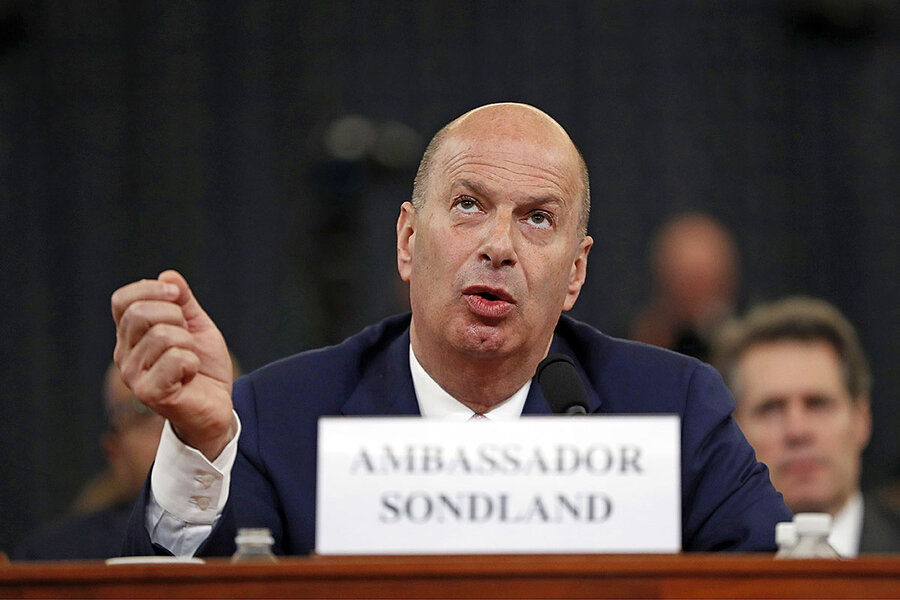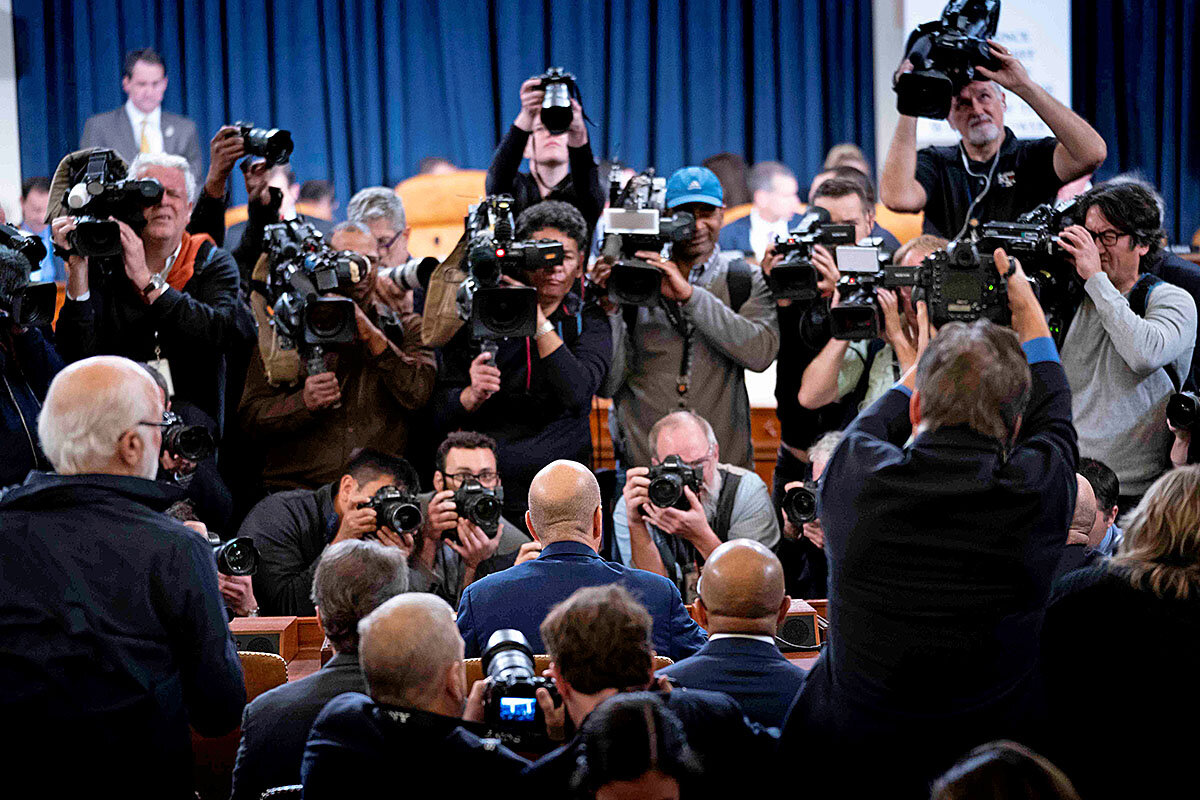Sondland impeachment testimony: Two perspectives
As the public phase of the Democratic-led House impeachment inquiry passes the one-week mark, Democrats and Republicans continue to look at witnesses and testimony through very different lenses. At times it seems almost as if the two parties are taking part in separate events.
Consider these scenes from Wednesday morning:
At the House, Intelligence Committee Chairman Adam Schiff seemed pleased with the way things were going. At the first break in the action in the impeachment inquiry, the California Democrat rushed to the hall outside the hearing room to hold an impromptu press conference/spin session.
Why We Wrote This
Hyperpartisanship isn’t simply about differences of opinion. In many ways, the right and the left are actually seeing different things. Here’s a look at two different perspectives on testimony from a key Trump administration figure.
New testimony from Gordon Sondland, the U.S. ambassador to the European Union, implicated senior administration officials – from President Donald Trump on down – in an effort to pressure Ukraine into launching investigations that could damage the president’s political opponents, Representative Schiff said.
“This is a very important moment in the history of this investigation,” he told reporters.
Across town, President Trump was very clear he did not consider it an important moment at all. Over the whine of a Marine helicopter waiting to whisk him to Andrews Air Force Base, President Trump repeated words from a Sept. 9 phone call with Mr. Sondland, in which he said there was no quid pro quo with Ukraine, he wanted nothing from them, and that Ukrainian President Volodymyr Zelenskiy just needed to “do the right thing.”
“This is the final word from the president of the United States: ‘I want nothing,’” said President Trump before turning to leave on a trip to Austin, Texas.
Here is a look at the split-screen positions of the two sides as revealed in Ambassador Sondland’s public testimony:
How Democrats see it
To Democrats the big news of Ambassador Sondland’s testimony, and one of the biggest moments in the impeachment inquiry to date, was simply the witness opening statement.
Mr. Sondland publicly made clearer than previously that in his view the U.S. did indeed push Ukraine for favors, specifically the opening of several investigations that could politically benefit President Trump at home, in exchange for things Ukraine wanted, such as a White House visit for President Zelenskiy.
“I know that members of this committee have frequently framed these complicated issues in the form of a simple question: Was there a ‘quid pro quo’? ... the answer is yes,” said Ambassador Sondland in his statement.
Democrats also said the E.U. ambassador’s testimony tied the president more closely to this decision than previously known. Mr. Sondland testified that he, Secretary of Energy Rick Perry, and former U.S. Special Envoy to Ukraine Kurt Volker worked with President Trump’s personal lawyer Rudy Giuliani on Ukraine issues at the “express direction” of the president.
“We did not want to work with Mr. Giuliani. Simply put, we played the hand we were dealt,” Ambassador Sondland’s statement said.
It was Mr. Giuliani who kept pushing for investigations that could benefit President Trump, and Mr. Sondland and others assumed those orders were coming from the Oval Office. At first, it was a desired visit to the White House for the Ukrainian leader that was endangered unless the Ukrainians announced the beginning of investigations. Later, Ambassador Sondland said, he “came to the conclusion” that U.S. military aid was endangered as well, although he was careful to state he never had such an indication from President Trump himself.
Democrats also felt that Ambassador Sondland’s testimony documented that top officials from Secretary of State Mike Pompeo to Acting Chief of Staff Mick Mulvaney knew about the alleged quid pro quos and were fully “in the loop,” in Ambassador Sondland’s words, about Mr. Giuliani’s parallel Ukraine policy track.
At one point, for instance, Ambassador Sondland emailed Secretary Pompeo and asked if it would be a good idea for President Trump to take a few minutes on a scheduled trip to Warsaw to break away and speak to President Zelenskiy, to help Mr. Trump to see that his Ukrainian counterpart could be a positive partner.
“Yes”, Mr. Pompeo replied. (The trip to Warsaw was cancelled so the meeting never took place.)
In the end, in the Democratic view, Ambassador Sondland described a situation in which virtually all the important actors in the U.S. government were urging greater American support for Ukraine in the name of national security, via aid and personal contact. Only the president and his personal lawyer differed, for opaque, personal reasons.
“I really regret that the Ukrainians were placed in that predicament, but I do not regret doing what I could to try to break the log jam,” Mr. Sondland said.
How Republicans see it
To members of the GOP, the Democrats were spiking the football in perceived triumph without having scored a touchdown, or indeed moved the ball at all.
A word they used throughout the day Wednesday was “presumption.” Ambassador Sondland said that a Ukrainian White House visit and U.S. military aid to Ukraine were contingent on investigations of former Vice President Joe Biden and his son Hunter Biden; the latter’s job at a Ukrainian energy company; and into alleged Ukrainian interference in the 2016 U.S. election. But Republicans pointed out over and over that he’d never heard that from President Trump himself. He simply presumed that Mr. Giuliani was conveying presidential wishes.
“Did the president ever tell you personally about preconditions for anything?” asked Stephen Castor, a lawyer for the Republican minority, at Wednesday’s hearing.
“No,” Ambassador Sondland replied.
Republicans also wondered aloud why Mr. Sondland had not included a reference to his Sept. 9 phone call with President Trump in his opening statement.
Ambassador Sondland made that call after other U.S. diplomats questioned whether military aid for Ukraine was being delayed, on purpose, by the president. In previous testimony, Mr. Sondland said that the call was brief and the chief executive was in a poor mood.
“What do you want from Ukraine?” Ambassador Sondland asked, according to previous testimony.
“I want nothing,” President Trump replied. “I want no quid pro quo. I want Zelensky to do the right thing.”
It was this call that the president himself talked about Wednesday as he was leaving for Texas.
White House press secretary Stephanie Grisham added in a statement that this was “one of the few brief phone calls” the pair had engaged in, and that in fact Ukraine has not experienced any sort of penalty in regards to some perceived quid pro quo.
“The U.S. aid to Ukraine flowed, no investigation was launched, and President Trump has met and spoken with President Zelenskiy. Democrats keep chasing ghosts,” said Ms. Grisham’s statement.
In Congress not all Republicans flat out denied a quid pro quo’s existence. Some GOP senators have long felt that President Trump’s best defense would be to acknowledge that a quid pro quo may have been set up, but it never occurred. In any case it was a normal and acceptable way of carrying out foreign policy, which is any president’s prerogative.
“The fact there was, that fact that there may be a quid pro quo is meaningless. Now, if you want to talk about an illegal quid pro quo, that’s relevant,” said Republican Sen. John Kennedy of Louisiana.
The GOP has also turned somewhat on Ambassador Sondland and begun to question his recollections per se. From the first, the White House has not seemed sure about how to handle him – a big Trump campaign donor who was a foreign policy novice and didn’t seem entirely committed to defending the president.
Both Vice President Mike Pence and Secretary Perry issued statements Wednesday denying that interactions with Ambassador Sondland described in his testimony ever took place. And in the inquiry hearing, GOP counsel Mr. Castor decried the ambassador’s admitted lack of notes, spotty memory, and occasional reliance on speculation – a “trifecta of unreliability,” in Castor’s words.
“We’re talking about the impeachment of the president of the United States. The evidence ought to be pretty darn good,” Mr. Castor said.










